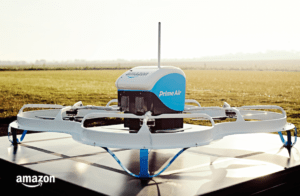
Amazon seems undaunted, continuing to move forward on drone delivery despite continued regulatory resistance. They introduced the newest version of their delivery drone – under strict supervision by security guards – this weekend at the SXSW technology conference in Austin, TX.

While the new drone looks remarkably similar to an older model, displayed above, it’s quite different in form from the drone used in their first demonstrated delivery, pictured below left – and also significantly different from this earlier version also shown by Amazon on their site and in promotional video (pictured right.)
Despite the display of Amazon’s new aircraft, and regardless of which model the company eventually uses, Amazon has not yet laid out exact plans for how packages might be delivered to doorsteps. In the video demonstrating their first completed drone delivery (see below), to a home near Amazon’s test site in the UK, the package was simply deposited gently on the wide, open front lawn – a method that may be less practical on the streets of Boston or New York.
There is no doubt that they’re working on it. A flurry of patents ranging from birdhouse-like charging stations, parachutes, drones on top of trucks, and drone protection systems have come from the Amazon team in the last year. Jeff Bezos continues to mention drone delivery in almost every speech he gives, reiterating the company’s commitment to drone delivery. Testing continues in the UK. But regulations here in the US still have not shifted enough to make drone delivery from warehouse to your house a realistic proposition.
Amazon’s drone delivery plans are part of a vast strategy in the works to take control of their delivery cycle. They’ve been buying cargo planes and road vehicles while they change their warehousing systems. But drone delivery, the promised 30 minute prize, is not yet a reality. In the meantime, other companies such as UPS are working on a smaller strategy: getting packages most of the way by truck, but focusing on very short distance deliveries – from the truck – some of the time. Even if a staff driver with two deliveries on the same street walks up to one step while a drone delivers the second, the saving are huge – and maybe more quickly realized.
Miriam McNabb is the Editor-in-Chief of DRONELIFE and CEO of JobForDrones, a professional drone services marketplace, and a fascinated observer of the emerging drone industry and the regulatory environment for drones. Miriam has penned over 3,000 articles focused on the commercial drone space and is an international speaker and recognized figure in the industry. Miriam has a degree from the University of Chicago and over 20 years of experience in high tech sales and marketing for new technologies.
For drone industry consulting or writing, Email Miriam.
TWITTER:@spaldingbarker
Subscribe to DroneLife here.

